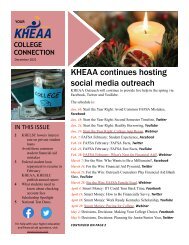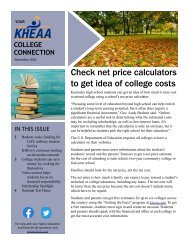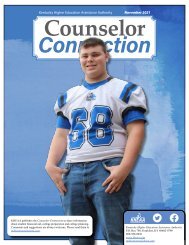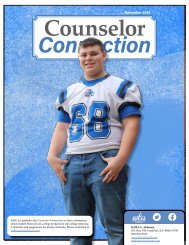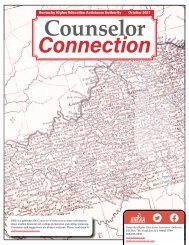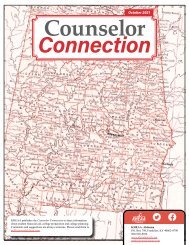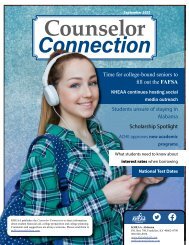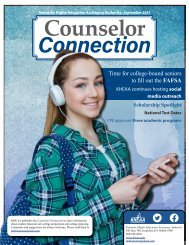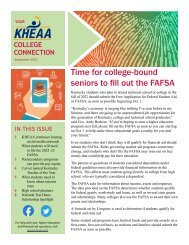AL - Counselor Connection - September 2020
- No tags were found...
You also want an ePaper? Increase the reach of your titles
YUMPU automatically turns print PDFs into web optimized ePapers that Google loves.
C o u n se lo r C o n n e c t io n<br />
S e p te m b e r 2 02 0<br />
Time for college-bound<br />
seniors to fill out the FAFSA<br />
High school seniors planning to attend college or technical<br />
school next fall should fill out the Free Application for<br />
Federal Student Aid, or FAFSA, as soon as possible<br />
beginning Oct. 1.<br />
The information on the FAFSA determines if students<br />
qualify for federal grants and student loans. It is also<br />
required to apply for state grants and scholarships. In<br />
addition, many colleges use the information to award their<br />
own grants and scholarships.<br />
In This Edition<br />
What students need for the<br />
FAFSA<br />
Social media sessions<br />
Financial aid webinars<br />
Scholarship Spotlight<br />
FAFSA Completion Guide<br />
2<br />
2<br />
3<br />
3<br />
4–7<br />
The FAFSA asks for information about income, assets and<br />
expenses. A formula set by Congress determines eligibility<br />
for federal and state aid. If the student is considered a<br />
dependent under federal guidelines, both the student and<br />
parents must provide financial information. Nearly all<br />
students going directly to college from high school are<br />
considered dependent.<br />
Some student aid programs have limited money and<br />
provide funds on a first-come, first-served basis, so it’s<br />
important for families to submit the FAFSA as soon as<br />
possible.<br />
Even if they don’t think they’ll qualify for financial aid,<br />
students should submit the FAFSA. They may be surprised,<br />
because student aid rules change all the time.<br />
The FAFSA should be submitted at studentaid.ed.gov/sa/<br />
fafsa. Students who do not have an FSA ID, which is needed<br />
to file the FAFSA, must first visit fsaid.ed.gov to set one up.<br />
Parents of dependent students must also set up an FSA ID.<br />
Kentucky Higher Education Assistance Authority<br />
P.O. Box 798<br />
Frankfort, KY 40602-0798<br />
Tel: 800.928.8926<br />
www.alstudentaid.com<br />
publications@kheaa.com<br />
KHEAA publishes the <strong>Counselor</strong> <strong>Connection</strong><br />
to share information about student financial<br />
aid, college preparation and college planning.<br />
Comments and suggestions are always welcome.<br />
Please send them to publications@kheaa.com.<br />
1
C o u n se lo r C o n n e c t io n<br />
What students need for the FAFSA<br />
In addition to an FSA ID, students will need the following<br />
to file the FAFSA:<br />
• Social Security number.<br />
• Driver’s license number (if they have one).<br />
• 2019 tax records. On the 2021–2022 FAFSA,<br />
students and parents will use their 2019 income<br />
information.<br />
• Records of untaxed income. This may not apply to<br />
everyone. It includes things like child support received,<br />
interest income and veterans’ non-education benefits.<br />
• Records of assets. Includes savings and checking<br />
account balances, as well as the value of investments<br />
such as stocks and bonds and real estate (but not the<br />
home in which the family lives).<br />
• List of interested schools. Even if there is only a<br />
slight chance they will apply to a college, they should<br />
list the school on the FAFSA. They can always remove<br />
schools later. If they wait to add a school, they could<br />
miss out on first-come, first-served financial aid.<br />
KHEAA continues hosting<br />
social media outreach<br />
KHEAA Outreach will continue to provide live help via<br />
Facebook, Twitter and Instagram. The schedule is:<br />
• Sept. 29: FAFSA Week: FAFSA Trivia, Facebook<br />
• Sept. 30: FAFSA Week: To Pay Back or Not Pay<br />
Back, Twitter<br />
• Oct. 1: FAFSA Week: The Early Bird Gets the<br />
Worm, Instagram<br />
• Oct. 6: FAFSA Feature: FSA ID Boot Camp,<br />
Facebook<br />
• Oct. 7: FAFSA Feature: Needed Documents,<br />
Twitter<br />
• Oct. 8: FAFSA Feature: Special Circumstances<br />
for the FAFSA, Instagram<br />
• Oct. 13: FAFSA Faux Pas: Avoiding Common<br />
Mistakes, Facebook<br />
• Oct. 14: FAFSA Faux Pas: Next Steps After<br />
Completing the FAFSA, Twitter<br />
• Oct. 15: FAFSA Faux Pas: The Risks of Not<br />
Completing the FAFSA, Instagram<br />
• Oct. 20: Real Talk: Real Life Getting In,<br />
Facebook<br />
• Oct. 21: Real Talk: Ways to Pay, Twitter<br />
• Oct. 22: Real Talk: Admit Me, Instagram<br />
• Oct. 27: FAFSA Follow Up: KASFAA Panel,<br />
Facebook<br />
• Oct. 28: FAFSA Follow Up: Frequently Asked<br />
Questions, Twitter<br />
• Oct. 29: FAFSA Follow Up: Discussing<br />
Dependency, Instagram<br />
All sessions begin at 3 p.m. Eastern, 2 p.m. Central.<br />
The links are:<br />
• www.facebook.com/KHEAA/<br />
• www.twitter.com/KHEAA<br />
• www.instagram.com/kheaaoutreach/?hl=en<br />
2
C o u n se lo r C o n n e c t io n<br />
KHEAA to hold webinars<br />
about financial aid<br />
During the fall semester, KHEAA Outreach is offering<br />
a series of webinars about financial aid and financial<br />
literacy. The schedule is:<br />
• Paying for College 101, , Monday, Sept. 29, noon.<br />
• FAFSA Frenzy: A FAFSA How To, , Wednesday,<br />
Oct. 1, noon.<br />
• FAFSA Frenzy: A FAFSA How To, , Wednesday,<br />
Oct. 8, 7 p.m.<br />
• FAFSA Frenzy: A FAFSA How To, , Wednesday,<br />
Oct. 15, noon.<br />
• FAFSA Frenzy: A FAFSA How To, , Wednesday,<br />
Oct. 22, 7 p.m.<br />
• FAFSA Frenzy: A FAFSA How To, , Wednesday,<br />
Oct. 29, noon.<br />
• Adults Returning to College, , Wednesday, Nov.<br />
19, 7 p.m.<br />
• It’s Money, Baby: A Guide to Financial<br />
Literacy, , Wednesday, Dec. 17, 7 p.m.<br />
All times listed are Eastern time.<br />
To register for a webinar, visit https://kygoestocollege.<br />
com/. That page also has links to videos of previous<br />
webinars.<br />
Scholarship Spotlight<br />
The Hydrographic Society of America — Southeast<br />
Chapter Scholarship<br />
Eligibility: The applicant must:<br />
• Attend college or university in Alabama, Arkansas,<br />
Florida, Georgia, Louisiana, Oklahoma, Mississippi or<br />
South Carolina.<br />
• Be enrolled full time in a 2-year, 4-year or graduate<br />
program.<br />
• Demonstrate a keen interest in hydrographic surveying<br />
or a related field.<br />
• Be a U.S. citizen or permanent resident.<br />
In addition, the applicant must submit:<br />
• An online application.<br />
• A résumé.<br />
• A 750-word essay explaining career goals.<br />
• A high school or college transcript.<br />
• 1 letter of recommendation from a faculty member.<br />
The transcript and letter should be submitted directly to<br />
THSOA by the institution and faculty member.<br />
Number: 5<br />
Award: $1,000<br />
Deadline: Nov. 30<br />
Contact: THSOA-Southeast Chapter Education<br />
Committee, Attn: Scholarships, PO Box 60341, Lafayette,<br />
LA 70596; thsoa_southeastchapter@yahoo.com; www.<br />
thsoa.org/<br />
3
2021–2022<br />
FAFSA Completion Guide<br />
FAFSA.gov financial aid application process<br />
Visit studentaid.<br />
gov/fsa-id/createaccount<br />
to create<br />
an FSA ID so you<br />
can submit and sign<br />
your FAFSA online.<br />
Complete the FAFSA<br />
and submit as soon<br />
as possible starting<br />
October 1. Apply<br />
online at fafsa.gov.<br />
If selected for<br />
verification, turn in<br />
documentation<br />
your financial aid<br />
office needs<br />
for completion.<br />
Review your Student<br />
Aid Report (SAR) to<br />
find out your family’s<br />
EFC.<br />
Make corrections and<br />
resubmit if necessary.<br />
Start your FAFSA here.<br />
Make sure you select the<br />
FAFSA for the year you will<br />
be entering college.<br />
What you will need:<br />
Dependent students will also need the following information for their parents.<br />
If you started a FAFSA<br />
but didn’t finish, you<br />
will go here.<br />
m Email address or mobile phone number.<br />
m FSA ID for both the student and the dependent<br />
student’s parent/stepparent.<br />
m Your Social Security number.<br />
m Your alien registration number (if you are not a<br />
U.S. citizen.)<br />
m Your 2019 federal income tax returns, W-2s, and<br />
other records of money earned.<br />
m Bank statements and records of investments (if<br />
applicable.)<br />
m Records of untaxed income (if applicable.)<br />
m Parents’ date of birth, Social Security number,<br />
marital status, and date parent was married,<br />
divorced, or widowed.<br />
Need help? Call Federal Student Aid at 800.433.3243<br />
4
Use your FSA ID to confirm your identity when you access<br />
your financial aid information and electronically sign your<br />
federal student aid documents, including the FAFSA.<br />
1 2 3 4 5<br />
Federal Student Aid ID<br />
Visit<br />
studentaid.gov/<br />
fsa-id/createaccount.<br />
Create a memorable<br />
username and<br />
password.<br />
Keep track of your FSA ID since you’ll use it<br />
frequently throughout the federal student aid<br />
application process each year.<br />
Enter your name,<br />
date of birth,<br />
Social Security<br />
number, contact<br />
information,<br />
and challenge<br />
questions and<br />
answers.<br />
Confirm your cell<br />
phone number<br />
using the secure<br />
code, which will<br />
be texted to the<br />
number you<br />
provided.<br />
Confirm your email<br />
address using the<br />
secure code, which<br />
or will be sent to the<br />
email address you<br />
entered when you<br />
created your FSA ID.<br />
Tip for Step 4:<br />
Providing a mobile phone number will give you access to make it<br />
easier to log in to ED online systems, unlock your account, retrieve<br />
your forgotten username, or reset your forgotten password.<br />
Are you dependent or independent?<br />
If you answer “Yes” to any question below, you are considered an independent student.<br />
m Were you born before January 1, 1998?<br />
m As of today, are you married? (Answer “Yes” if you<br />
are separated but not divorced.)<br />
m At the beginning of the 2021–2022 school year,<br />
will you be working on a master’s or doctoral<br />
program (such as an MA, MBA, MD, JD, PhD, EdD, or<br />
graduate certificate, etc.)?<br />
m Are you currently serving on active duty in the U.S.<br />
Armed Forces for purposes other than training?<br />
m Are you a veteran of the U.S. Armed Forces?<br />
m Do you now have or will you have children who will<br />
receive more than half of their support from you<br />
between July 1, 2021, and June 30, 2022?<br />
m Do you have dependents (other than your children<br />
or spouse) who live with you and who receive more<br />
than half of their support from you, now and<br />
through June 30, 2022?<br />
m At any time since you turned age 13 were both of<br />
your parents deceased, or were you in foster care,<br />
or were you a dependent or ward of the court?<br />
m As determined by a court in your state of legal<br />
residence, are you now or were you, upon reaching<br />
the age of majority, an emancipated minor<br />
(released from control by your parent or guardian)?<br />
m As determined by a court in your legal state of<br />
residence, are you now or were you, upon reaching<br />
the age of majority, in legal guardianship (of<br />
someone other than your parent or stepparent)?<br />
Note: Custody is different from guardianship.<br />
m At any time on or after July 1, <strong>2020</strong>, did your high<br />
school or school district homeless liaison, the<br />
director of an emergency shelter or transitional<br />
housing program funded by the U.S. Department<br />
of Housing and Urban Development, the director<br />
of a runaway or homeless youth basic center, or<br />
transitional living program or a college financial<br />
aid administrator determine that you were an<br />
unaccompanied youth who was homeless or were<br />
self-supporting and at risk of being homeless?<br />
Notes<br />
5
Whose information do I use?<br />
The intent of the FAFSA is to get an idea of your household income. Use the guide on page 2<br />
to determine if you are a dependent student. If you are dependent, use this guide to figure<br />
out which parent’s information to include.<br />
m Are your parents married to each other? If yes, then report information for both parents on the FAFSA.<br />
m Do your parents live together? If yes, then report information for both parents on the FAFSA, even if they were<br />
never married, are divorced, or are separated.<br />
m Did you live with one parent more than the other over the<br />
past 12 months?<br />
• If yes, then report information on the FAFSA for<br />
the parent you lived with more. Also, if this parent<br />
remarried, you will need to report information for<br />
your stepparent on the FAFSA even though he or she<br />
may not be responsible for your college costs.<br />
• If no, then report information on the FAFSA for the<br />
parent who provided more financial support over<br />
the past 12 months or in the last year you received<br />
support. Also, if this parent is remarried, you will<br />
need to report information for your stepparent on<br />
the FAFSA.<br />
The following people are NOT your parents<br />
UNLESS they have legally adopted you:<br />
m Widowed stepparents<br />
m Grandparents<br />
m Foster parents<br />
m Legal guardians<br />
m Older brothers or sisters<br />
m Aunts or uncles<br />
SIMPLE STEPS TO TRANSFER TAX INFORMATION INTO YOUR FAFSA ®<br />
The IRS Data Retrieval Tool (IRS DRT) Electronically Transfers Your Federal Tax Return Information into your FAFSA ®<br />
For Students and Parents<br />
INCOME<br />
TAX FORMS<br />
Log in to your current<br />
FAFSA, or start a new<br />
FAFSA at fafsa.gov<br />
In the finances section of<br />
the FAFSA, you will see a<br />
“Link to IRS” button if<br />
you are eligible to use<br />
the IRS DRT.<br />
Click the “Link to IRS”<br />
button and log in with<br />
your FSA ID to be<br />
transferred to the IRS<br />
to retrieve your info.<br />
IRS DRT<br />
IS SECURE<br />
For your protection, your<br />
tax information will not<br />
be displayed on either<br />
the IRS site or fafsa.gov.<br />
INCOME<br />
TAX FORMS<br />
Once at the IRS site, enter<br />
your name and address<br />
exactly as it appears on<br />
your federal income tax<br />
return and click the<br />
“Submit” button.<br />
Check the “Transfer My Tax<br />
Information into the FAFSA”<br />
box, and click the “Transfer<br />
Now” button.<br />
You will know you have<br />
been successful<br />
because the words<br />
“Transferred from the<br />
IRS” will display in<br />
place of the IRS<br />
information on your<br />
FAFSA form.<br />
To learn more about the IRS DRT, visit StudentAid.gov/irsdrt<br />
Graphic adapted from U.S. Department of Education<br />
SUBMIT<br />
6
Assets<br />
m Asset net worth means current value of the assets<br />
minus what is owed on those assets.<br />
m Assets include: money in cash, savings, and<br />
checking accounts; businesses (over 100<br />
employees); investment farms; other investments,<br />
such as real estate (other than the home in which<br />
you live); UGMA and UTMA accounts for which<br />
you are the owner; stocks, bonds, certificates of<br />
deposit, etc.<br />
m Assets do not include: the home and farm where you<br />
live; UGMA and UTMA accounts for which you are the<br />
custodian but not the owner; value of life insurance;<br />
retirement plans (401[k] plans, pension funds,<br />
annuities, non-education IRAs, Keogh plans, etc.)<br />
Communication<br />
m Use a personal email (not school) that you check<br />
often for the FSA ID and the FAFSA. You will<br />
receive IMPORTANT information and directions<br />
via email.<br />
Data security<br />
m Each email address or mobile phone number<br />
can be used with only one FSA ID. If you share<br />
an email address with someone else, then only<br />
one of you will be able to use that email address<br />
to create an FSA ID. This applies to your mobile<br />
phone number too.<br />
m Keep track of all usernames and passwords in a<br />
safe, secure place. You will need your FSA ID every<br />
year you complete a FAFSA, as well as to log in to<br />
all Department of Education websites.<br />
Helpful Hints<br />
Next Steps<br />
Verification<br />
Colleges are required to verify the information provided on<br />
some FAFSAs. Most people selected for verification are picked<br />
at random.<br />
If you’re selected for verification, you’ll be contacted by the<br />
college. The college or, in some cases, an agency with which<br />
the college has contracted will let you know what forms and<br />
information you need to supply.<br />
If you are chosen for verification,<br />
DON’T PANIC. YOU HAVE DONE NOTHING WRONG!<br />
Don’t delay. It’s important to complete verification as soon as<br />
you’re notified so there are no delays with your financial aid.<br />
First year college students<br />
m The grade level for high school seniors and first-year<br />
students will be “Never attended college and 1st year<br />
undergraduate” even if you have taken AP or dual<br />
credit courses.<br />
m The question “What degree or certificate will you be<br />
working on when you begin the 2021–2022 school<br />
year?” is referring to the category or type of program<br />
and NOT college major. Refrain from choosing “Other/<br />
undecided.” First-year college students will not be in<br />
a graduate program.<br />
Important information<br />
m Name and Social Security number need to match what is<br />
on your Social Security card and tax forms, if applicable.<br />
m Tax filers should use the IRS Data Retrieval Tool to<br />
transfer income information from the IRS to the FAFSA<br />
if possible (both student and parent).<br />
m Review confirmation page and check your email as an<br />
indicator the FAFSA was submitted correctly.<br />
Website navigation<br />
m To get clarification and guidance for each data field,<br />
click on the question mark ? next to each data box to<br />
show HELP text.<br />
m The top of the screen will indicate whose information<br />
is needed on that page, either STUDENT or PARENT.<br />
When the FAFSA says “you,” it is referring to the<br />
student (not the parent).<br />
m Make sure that you select the correct form. High<br />
school seniors graduating in 2021 will need to<br />
complete the 2021–2022 FAFSA.<br />
m Your FAFSA will reset after 45 days if it isn’t<br />
submitted.<br />
Special circumstances<br />
If you believe you have special circumstances that<br />
were not accurately reflected on your FAFSA, contact<br />
the financial aid office at the college you plan to<br />
attend.<br />
Award notifications<br />
Once your FAFSA has been processed, your award<br />
notifications will come from the college(s) you listed<br />
on your FAFSA, once you’ve been accepted. Some<br />
colleges begin sending award<br />
letters in the fall, but many will<br />
wait until the spring.<br />
For more information about college planning services and financial aid programs<br />
available to Kentucky students, please visit kheaa.com or call 800.928.8926.<br />
KHEAA is an EEO Employer.<br />
7




